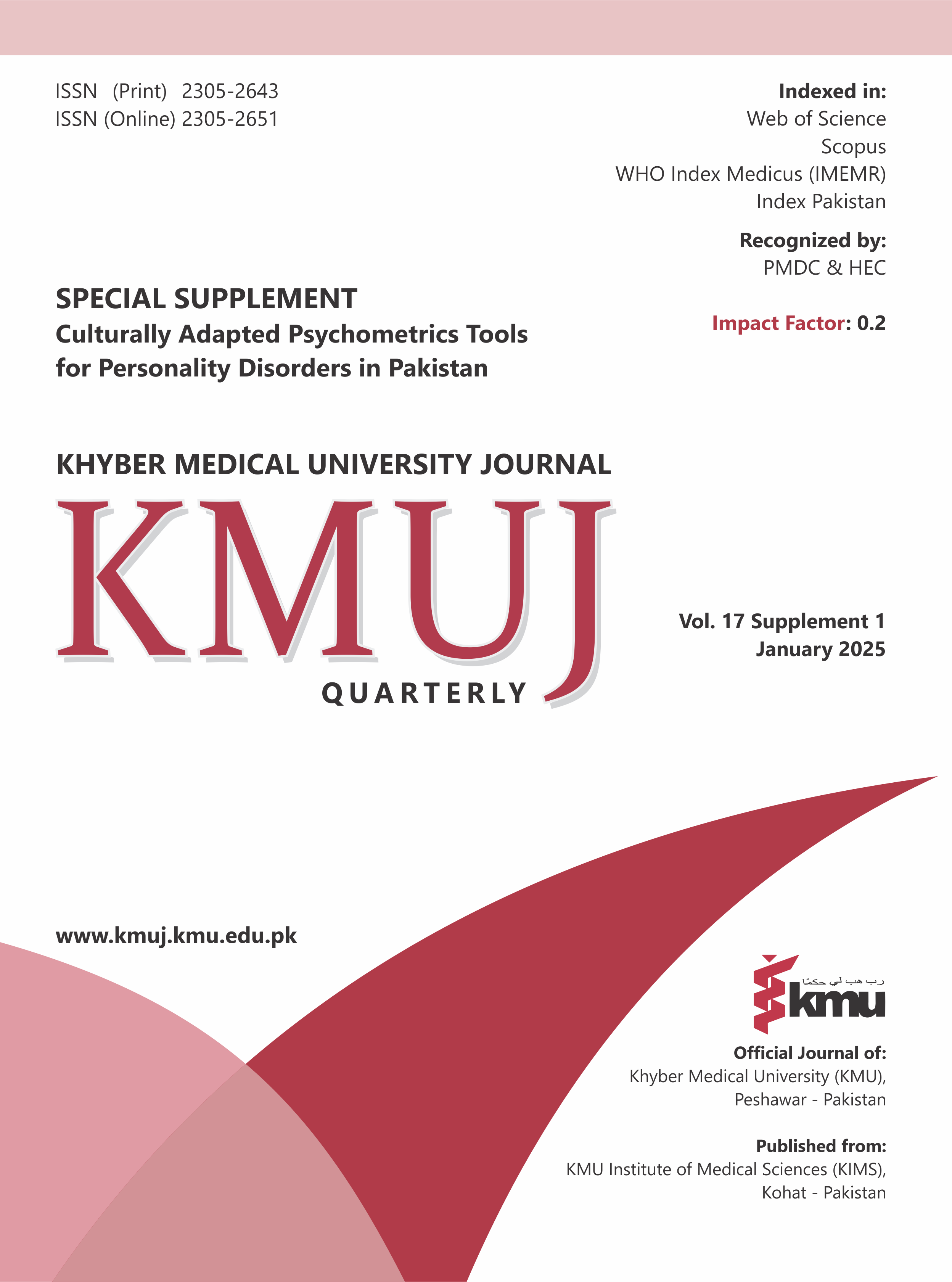Development and validation of an indigenous Urdu-language Dependent personality disorder scale for adults
Main Article Content
Abstract
Objective: To develop and validate an indigenous Dependent Personality Disorder Scale (DPDS) for adults, ensuring strong psychometric properties tailored to the cultural context of Pakistan.
Methods: A cross-sectional analytical design was employed, with ethical approval from the Departmental Research Review Committee at the University of Gujrat. Data collection occurred from February to June 2019 in Gujrat, Pakistan. Participants aged 19 and above, from various educational institutions, hospitals, and communities, were recruited using purposive sampling (N=234; 107 males, 127 females). The study involved two phases: scale development and validation. Initially, a pool of 104 items was created based on literature and expert input, reduced to 94 after expert review, and further refined to 52 items through exploratory factor analysis. Confirmatory factor analysis (CFA) validated a final 25-item scale with satisfactory model fit indices (CMIN/DF=2.108, CFI=0.908, RMSEA=0.069). Reliability was assessed using Cronbach's alpha, and construct validity was determined through convergent validity testing against an existing DPDS measure.
Results: The Kaiser-Meyer-Olkin value was 0.938, and Bartlett’s test of sphericity was significant (p < 0.001), supporting factor analysis suitability. Exploratory factor analysis revealed seven factors explaining 64.39% of the variance. The finalized scale demonstrated high internal consistency (α = 0.932). Subscale reliability ranged from 0.684 to 0.866. Convergent validity showed a strong positive correlation (r = 0.712, p < 0.01) with an established DPDS measure.
Conclusion: The 25-item DPDS is a psychometrically robust, reliable, and valid tool for assessing dependent personality disorder in Pakistani adults, with potential applicability in clinical and research settings.
Article Details

This work is licensed under a Creative Commons Attribution 4.0 International License.
Work published in KMUJ is licensed under a
Creative Commons Attribution 4.0 License
Authors are permitted and encouraged to post their work online (e.g., in institutional repositories or on their website) prior to and during the submission process, as it can lead to productive exchanges, as well as earlier and greater citation of published work.
(e.g., in institutional repositories or on their website) prior to and during the submission process, as it can lead to productive exchanges, as well as earlier and greater citation of published work.
References
1. Bornstein RF. Dependent personality disorder. In, Widiger TA (Editor), The Oxford handbook of personality disorders. Oxford University Press 2012:505-26. https://doi.org/10.1093/oxfordhb/9780199735013.013.0023
2. American Psychiatric Association. Diagnostic Statistical Manual for Mental Disorders. 5th ed. American Psychiatric Publications, Arlington, V.A. 2013;669-71.
3. Oldham JM, Morris LD. The New Personality Self-Portrait: Why You Think, Work, Love and Act the Way You Do. 1st ed. 1991. Bantam, New York, USA.
4. Miller L. From Difficult to Disturbed: Understanding and Managing Dysfunctional Employees. 1st ed. 2008. AMACOM, New York, USA.
5. Bornstein RF. The complex relationship between dependency and domestic violence: converging psychological factors and social forces. Am Psychol 2006;61(6):595-606. https://doi.org/10.1037/0003-066x.61.6.595
6. American Psychiatric Association. Diagnostic and statistical manual of mental disorders. 1st ed, 1952. American Psychiatric Association, Washington, DC.
7. American Psychiatric Association. Diagnostic and statistical manual of mental disorders. 2nd ed, 1968. American Psychiatric Association, Washington, DC.
8. American Psychiatric Association. Diagnostic and statistical manual of mental disorders. 3rd ed, 1980. American Psychiatric Association; Arlington, V.A.
9. Beitz K, Bornstein RF. Dependent personality disorder. In, Fisher JE, O'Donahue WT (eds), Practitioner's Guide to Evidence-based Psychotherapy. Springer, New York. 2006;230-37.
10. Tyrka AR, Wyche MC, Kelly MM, Price LH, Carpenter LL. Childhood maltreatment and adult personality disorder symptoms: influence of maltreatment type. Psychiatry Res 2009;165(3):281-7. https://doi.org/10.1016/j.psychres.2007.10.017
11. Amanda KS. The Effect of Sex and Gender Role Orientation on Attitudes towards Individuals with Dependent Personality Disorder (A dissertation). 2012. Indiana State University Terre Haute, Indiana. Accessed on: January 07, 2023. Available from URL: https://scholars.indianastate.edu/etds/1468/
12. Tay L, Jebb A. Scale Development. In: Rogelberg SG (editor), The SAGE Encyclopaedia of Industrial and Organizational Psychology. 2nd ed. 2017. SAGE Publications, New Delhi, India. https://doi.org/10.4135/9781483386874
13. Awang Z. Validating the Measurement Model: CFA. In: A Handbook on SEM: Structural equation modelling using amos graphics. 4th ed. 2012:54-73.
14. Shahzadi A, Bano Z. Development of dependent personality disorder scale: role of nail biting among adults of Sialkot. Khyber Med Uni J 2020;12(4):278-83. https://doi.org/10.35845/kmuj.2020.19802
15. Simonelli A, Parolin M. Dependent personality disorder. Encycl Pers Individ Dif 2017;1-18. http://dx.doi.org/10.1007/978-3-319-28099-8-578-1
16. American Psychiatric Association. Diagnostic and statistical manual of mental disorders (5th ed., text rev.).2022. https://doi.org/10.1176/appi.books.9780890425787
17. Bornstein RF. The dependent personality: developmental, social, and clinical perspectives. Psychol Bull 1992;112(1):3-23. https://doi.org/10.1037/0033-2909.112.1.3
18. Tyrer P, Morgan J, Cicchetti D. The dependent personality questionnaire (dpq): a screening instrument for dependent personality. Int J Soc Psychiatry 2004;50(1):10-17. https://doi.org/10.1177/0020764004038754
19. Huber NM. Dependent Personality Inventory (DPI): A Scale to Assess Dependent Personality Subtypes Based on DSM-IV-TR Criteria. Unpublished Master’s Thesis, Cleveland, OH: Cleveland State University. 2005. Accessed on: January 07, 2023. Available from URL: https://engagedscholarship.csuohio.edu/cgi/viewcontent.cgi?article=1600&context=etdarchive
20. Gore WL, Presnall JR, Miller JD, Lynam DR, Widiger TA. A five-factor of dependent personality traits. J Pers Assess 2012;94:488-99. https://doi.org/10.1080/00223891.2012.670681
